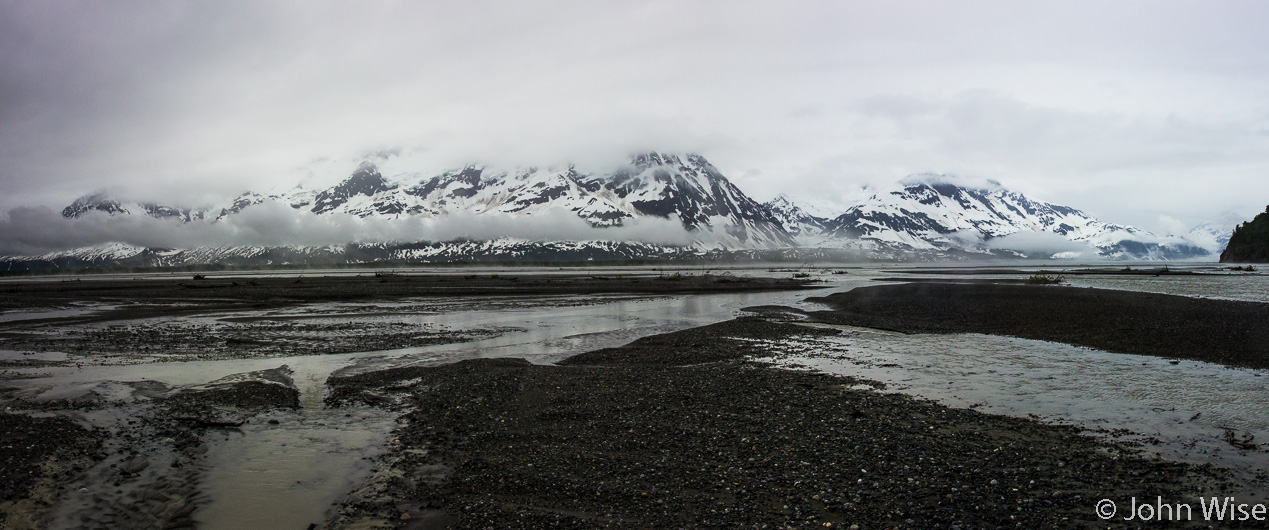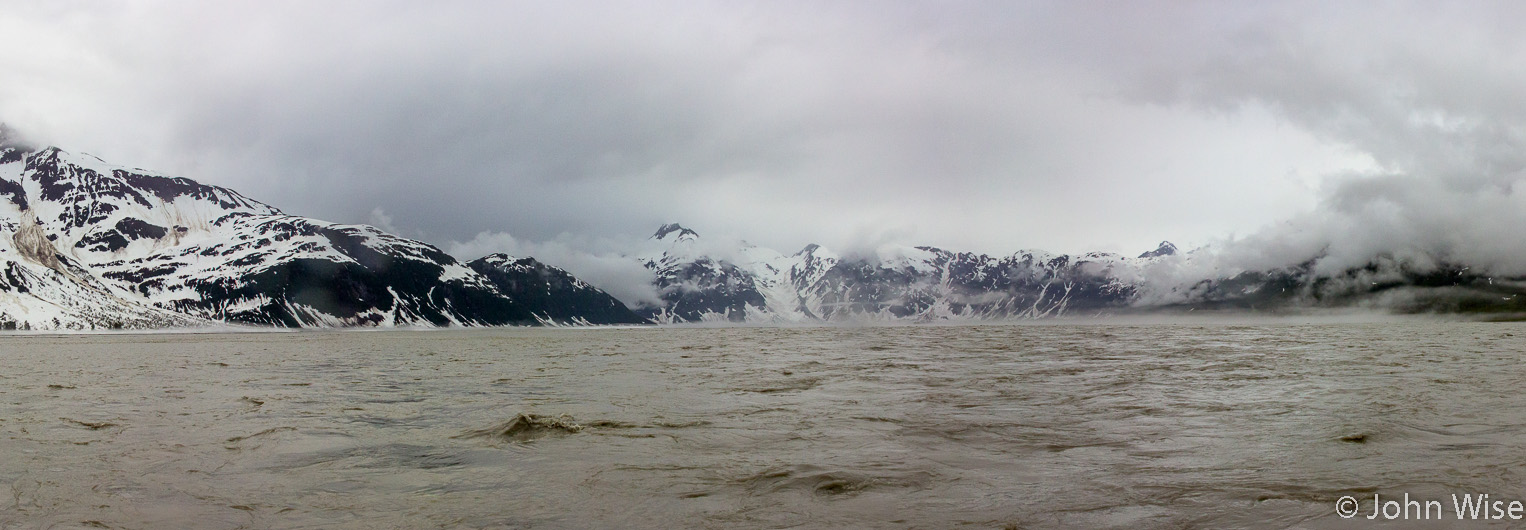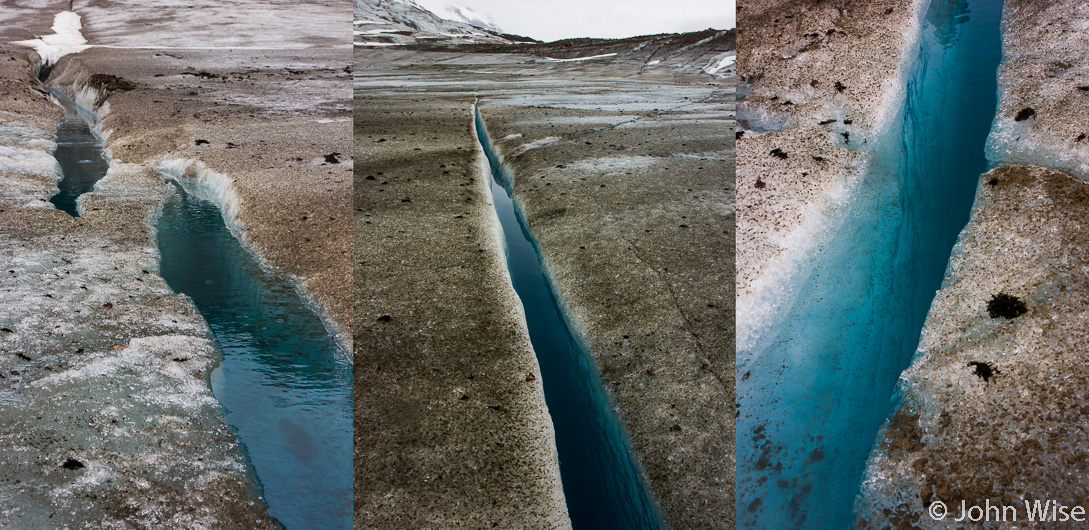
Caution: Merge Ahead! Mist is seen in the distance rising off the waters of the Tatshenshini River; the combined rivers are about to get mighty big. The ‘Tat,” as it is popularly known, is about to be consumed by the Alsek. On any other day, we might have seen other rafters paddling over there as those who opt to travel the Tat end up joining the Alsek. Fortunately, there isn’t much traffic through here, so no need to worry about collisions with other rafters or rush hour creating long waits to continue the journey downriver. By the way, see all that snow? It is almost July!

Time to collect firewood, as our trip leader, who knows this river well, isn’t sure we’ll be successful further downstream. Our landing is an island; behind us is the Alsek, and in front of us is the Tat – this is the riverbed of the combined rivers. It’s a peculiar notion that maybe a few days ago, this area was fully submerged or that in a day or two, it will once again have the waters of the Tatshenshini/Alsek spilling over it, but today we will scour it for driftwood.

This is our trip leader, Shaun Cornish. Like most boatmen, the guy is a difficult read. One characteristic I have found in the small sampling of boatmen I’ve encountered is that they all seem to possess a sense of brooding. I’m most likely wrong about this, as they are probably just so different than those of us who call big cities home, that they fall into a category of people most of us are unfamiliar with. After all, who else among us in our daily adult lives has so much responsibility for nearly everything we do? These guides into the wilds hope to see us travel safely; they feed us, look after our waste, are usually up before us, and go to sleep well after we do. Their decisions and the chemistry of their personalities will dictate many factors of how we will adapt to our environment and those around us. The load they endure and the torment of their bodies to work for us, who are almost without care, is admirable but may also go unseen by those who are not in tune with the sacrifice these hearty characters offer. I doubt they see themselves as anything special; they are slaves to the beauty of a place that mystifies and inspires them to their core, and so take solace that there are those of us who pay for them to once again visit these lands that defy understanding.

We are now in Alaska! We are also apparently heading into a place known as – The End Glacier. It appears that this is the end of the trail because, from our perspective, there is nowhere to go up ahead. The suspense is growing, just where does the river flow? What we do know right now is that it’s also really cold out here, so cold that up ahead where you can see a thin layer of mist rising off the water; well in fact, that mist is coming off an ice sheet. Suspense gives way to nervousness as we approach the ice sheet. It’s well over a foot thick, and initially, I can’t see a break in it. This could be serious at any step along this journey; if we find an insurmountable obstacle we can’t navigate around, that’s the end of the trip! We’ve heard the stories by now of crazy portages where passengers and crew can spend a day or two hauling gear over rough terrain just so they don’t have to quit their adventure before it’s really over. As you’ll see in the coming photos, we made our way past the ice sheet and found a way through, and without a portage over the ice or mountains. And which way does the river flow? Book yourself a journey into the amazing and find out on your own – you won’t be disappointed.

No photo, no words, no video can convey the feelings of passing under these towering snow-covered mountains that rise up almost right next to the river. The raft cruises along at about nine mph (15km). We might as well be on the Autobahn at these speeds or maybe there are drugs for dilating time to suspend one’s self in extended minutes that would appear to be hours or days where the imagination is allowed to linger in the splendor. This is the same problem I found in the Grand Canyon when presented with this kind of spectacle of beauty; the mind aches to consume every last vision of what it’s trying to grasp, but this is too much to take in with one viewing – oh, to be a boatman.

There it is, our next stop – Walker Glacier. Think about what you are seeing; those are full-height trees in front of the glacier. We are looking at a mountain of ice, and tonight, we camp in its shadow.

We landed, unpacked, set up camp, and immediately left for some serious bushwhacking. Through the muck and into the intertwined knot of brush, we cut a path, trying to find our way to the glacier made invisible by this thicket. It was all going well until on the other side of these trees when we came upon a steep embankment of gravel that my vertigo rebelled against. Neither the mind nor body wanted to overcome this bit of daredevil dance on the loose rocky earth. Again, I was foiled by the anxiety brought on by vertigo. I’d like to tell you how shitty it is to be stopped in my tracks and not being able to experience the next great part of this adventure, but I’m more at ease with the situation. You see, I look at it like this, “How much is enough?” Every moment of every day out here is nothing short of stupendous. I live in constant delight, and if this, that, or something else is allowed to be the defining moment of this journey, then I miss out on recognizing that everything up to this point was worthy of the greatest accolades one could offer. When the icing is already 1000 feet deep, what’s another inch?

Now, while I couldn’t get over my fears, that didn’t stop my wife! It took a lot of strength to turn my back on Caroline, knowing that she would be crossing this rock slide I couldn’t manage, but I did not want to deny her the excitement of what might be her only opportunity to walk on a glacier, and she was happy she did. This photo was taken as the rest of the group was crossing over the lateral moraine before connecting with the glacier. A moraine is a deposit of dirt and rocks that the glacier pushes forward or to the side as it extends.

Once out on the glacier, Caroline said it was like walking on air. While difficult to see in the photos, looking down, you could see through the ice. Shaun warned the group not to jump around, no horseplay, do not step on snowy patches, and stay together. Yes, that’s a stream running over the glacier.

In some places, you can take peeks deep into the heart of the ice: crevasses filled with ice melt. Impossible to gauge is how deep these channels are; one thing that is easy to surmise: falling into the freezing cold water and trying to crawl out on the ice would be tricky business. My knees buckle at the idea of standing on the edge of these intriguing blue slices on Walker Glacier.

This is how moraines are made; what earth and rocks that haven’t fallen to the side of the glacier will likely be taken all the way to the river? This giant golden boulder may have landed on the glacier thousands of years ago; next year, it might not be found again, or maybe it will remain where we left it; the glacier will determine its fate.

Look closely around the small patch of moss that is not soil; those small rocks and the hint of dirt are sitting on top of glacial ice; it’s just enough for life to take hold.

This is the reason you don’t stand on the snow; you never know what it might be hiding. There is no bottom down there, none that can be seen anyway. How deep does it go? Are the depths filled with a pool for freezing water? Maybe a river is flowing down there? Lucky us, no one on our trip slipped to find out. Caroline filled a bottle from one of the glacial streams with water so I could have my own Walker Glacier encounter. We dined on fajitas and talked late into the night. This was also my coming of age regarding the burning of the football. I finally got it right! In River Speak, the football is the brown paper bag of used toilet paper that sits next to the toilet. Toilet paper creates bulk, and we have very limited space; not only that, but it also creates weight, and at the end of the trip, everything will be flown out – everything. Except what can be burned. And so, at the end of the day, when all of the passengers have gone to sleep, the last boatman awake collects the brown paper bag. Picking it up wearing rubber gloves, the gloves are peeled off and wrapped around the bag full of TP – until it almost resembles a football. Now with no one else around to smell the burning shit and latex, the football is punted, passed, or tossed into the fire. But this is also where I still need some work on my river skills: while I can roll the ball around to cook away the ugly concoction, I have not yet mastered the Fire Donut. Shaun has attempted to teach me the art of creating the ring of embers, which, in boatman theory, arranges the remnants of our campfire into a perfect form that almost guarantees that by morning, only ash will remain. We aim for efficiency to travel wisely, to travel lightly, and to learn the sage lessons these people of the river can offer us night owls.
Oh to dance among the beauty and danger that life has to offer in such places as Alaska… and to burn shit footballs!